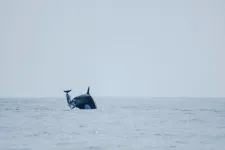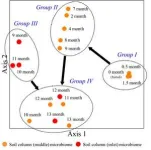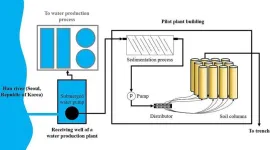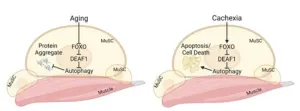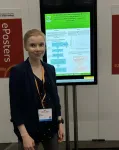(Press-News.org) Off the coast of Chile, in waters filled with krill and anchovy by the Humboldt Current system, live an elusive and little-known population of orcas. Thanks to citizen science and years of dedicated surveillance, a team of scientists led by Dr Ana García Cegarra of the Universidad de Antofagasta are unveiling their secrets — starting with dinner.
García Cegarra’s team, who previously observed these orcas using fishing boats to help them capture sea lions, have now spotted them successfully hunting dusky dolphins for the first time and sharing the food among the pod. This new evidence about their eating habits may help experts understand how populations of orcas in the southern hemisphere are linked, promoting conservation efforts.
“Studying orcas in their natural environment is very challenging as they are marine top predators, travelling long distances and living offshore, which makes observation difficult,” said García Cegarra, lead author of the study in Frontiers in Marine Science. “But understanding their role in the marine environment is crucial for the conservation of this poorly-known species in the Humboldt Current.”
You are what you eat
Orcas are apex predators with an impressively varied diet — but not all orcas eat the same things. Populations can be assigned to different ecotypes based on their preferred foods, acoustics, and genetics, so understanding what the orcas of the Humboldt Current eat is a major step towards understanding where they fit in among the other orcas of the world. Five different ecotypes are reported in the southern hemisphere: some, like Type A and Type B1 orcas, focus on marine mammals, while other types prefer fish. Understanding where the Humboldt Current animals fit in would help us understand the way these populations relate to each other more broadly and conserve them for the future.
García Cegarra and her colleagues used a combination of their own surveys and citizen science data collection from whale-watching trips and fishing vessels to monitor the population and track their hunting choices. Observers recorded the presence of orcas, group composition and location, and took pictures and videos which the scientists could cross-reference with catalogues of known individuals. By combining this data with their own systematic surveys and drone footage, the scientists built up a map of orca presence in the area and tracked pods’ behavior and prey choices.
This allowed the researchers to capture evidence of the Menacho pod of orcas catching dusky dolphins — a species no orcas in this area have ever been reported successfully hunting. Dramatic images show the matriarch, Dakota, tossing a dusky dolphin into the air.
These sightings could indicate that these orcas may belong to the mammal-hunting Type A ecotype. Their prey, and their small pod sizes, would be consistent with this hypothesis, although their white eye patches are smaller than is typical of Type A orcas. They have also never been recorded in Patagonia with other Type A orcas.
“We wish we could obtain skin biopsy samples to analyze their genetic data, as there is no genetic information for orcas in this region of the south-east Pacific,” said García Cegarra. “However, they are very elusive and intelligent, which makes it difficult to approach them in the boat for biopsies.”
Sharing the spoils
The scientists’ observations of the dusky dolphin hunting also revealed that the Menacho pod were sharing their food. Food sharing is recorded among many populations of orcas, sometimes to help feed kin, and sometimes because the pod hunts cooperatively and everyone gets a share. In this case, García Cegarra and her colleagues suggest that the Menacho pod were sharing food with kin, similar to Type A orcas who hunt sea lions by deliberately stranding: female orcas were seen sharing meat with group members, allowing closer relations to eat first.
García Cegarra emphasized that much more information and systematic study is necessary to fully understand and protect this secretive population of orcas. “The fact that we have observed newborn calves is important, because it indicates that they are having offspring, but we don’t know their survival rate,” she said. “Thanks to citizen science, we can follow the presence of killer whales along thousands of kilometers of the coast of northern Chile — but most orca sightings are opportunistic.”
END
Mysterious orca group near Chile tracked down, revealing newly discovered hunting skills
Dramatic new images of orcas in the Humboldt Current system hunting and eating dusky dolphins could help scientists learn more about all southern hemisphere orcas
2024-09-26
ELSE PRESS RELEASES FROM THIS DATE:
Treatment for major cause of recurrent pregnancy loss
2024-09-26
Amongst women who experience recurrent pregnancy loss, around 20% test positive for a specific antibody that targets the mother’s own body. A Kobe University-led research team now found a treatment that drastically increases these women’s chances of carrying to full-term without complications.
Recurrent pregnancy loss is a condition of women who have lost two or more pregnancies for non-obvious reasons. The Kobe University obstetrician TANIMURA Kenji and his team have previously found that in 20% of these women, they can detect a specific antibody in ...
In an era of climate change, clean water and reliable water storage for floods and droughts is a possibility!
2024-09-26
In recent years, the world has seen a recurrence of extreme floods and droughts due to climate change. In response to this, aquifer storage technology is being used for actual water supply in countries such as the United States, the Netherlands, and Australia. In South Korea, it rains intensively in the summer and extreme rainfall occurs, causing increasing difficulties in water supply in rural areas and island areas other than urban areas. In this situation, aquifer storage technology is attracting attention as a way to stably store and supply water.
Dr. Seongpil Jeong and Kyungjin Cho of the Center for Water Cycle Research at the Korea ...
Risk of buprenorphine triggering sudden opioid withdrawal is low
2024-09-26
Buprenorphine, an evidence-based treatment for opioid use disorder, is currently underprescribed because of concerns that it can cause ‘precipitated withdrawal’, in which the first dose causes sudden, intense pain and anxiety that resolves within a few hours. A new review of the best available evidence has found that the rate of buprenorphine-precipitated withdrawal in adults with opioid use disorder is low and should not be a barrier to use. The review is published in the scientific journal Addiction.
Lead author Dr Caroline Gregory, of the University of Ottawa, explains: “There is a lot of speculation ...
FAIR Health releases interactive tool tracking opioid abuse and dependence state by state
2024-09-26
NEW YORK, NY—September 26, 2024—Today FAIR Health released the Opioid Tracker, a free, interactive tool tracking opioid abuse and dependence state by state. A brief released simultaneously offers a user’s guide to the Opioid Tracker.
Available on FAIR Health’s website fairhealth.org, the Opioid Tracker includes a heat map representing the percentage of patients with opioid abuse and dependence diagnoses compared to all patients receiving medical services in 2023 for each state. Clicking on a state displays an infographic for ...
Duke-NUS discovery advances quest for treatment for age- and cancer-related muscle degeneration
2024-09-26
With the global population ageing rapidly, sarcopenia, a condition that affects millions of older adults and severely diminishes their quality of life, is emerging as an urgent public health issue. Now, a new discovery by scientists at Duke-NUS Medical School could lead to improved treatments for the condition.
In the study, published in the journal Autophagy, the scientists found that the levels of a certain type of protein, called DEAF1 (Deformed epidermal autoregulatory factor-1), need to be maintained within optimal levels ...
Women with premature ovarian insufficiency are at greater risk of severe autoimmune diseases
2024-09-26
Severe autoimmune conditions such Type I diabetes, Addison’s disease, lupus and inflammatory bowel disease, are between two to three times more common in women who have been diagnosed with premature ovarian insufficiency (POI) compared to the general population.
The research, published today (Thursday) in Human Reproduction, one of the world’s leading reproductive medicine journals, is the largest to investigate the link between autoimmune conditions and POI, has followed nearly 20,000 women for ...
Remote video consultations linked to reduced depression and anxiety
2024-09-25
Remote video consultations between patients and mental health specialists show a small but significant improvement on symptoms of depression and anxiety, finds a trial published by The BMJ today.
Although the effect size is small, the researchers say the effect is still meaningful given the high levels of these disorders in the community.
Globally, depression and anxiety disorders are among the top leading causes of years lived with disability, but most people with depression and anxiety ...
Questions over safety and effectiveness of new Alzheimer’s drug
2024-09-25
The safety and effectiveness of donanemab - an Alzheimer’s drug recently approved by the US Food & Drug Administration (FDA) - is called into question in an investigation published by The BMJ today.
Journalists Jeanne Lenzer and Shannon Brownlee explore concerns not only about its effectiveness and the number of deaths among patients taking the drug, but also about financial ties to drug makers among the “independent” advisory panellists who recommended approval.
Donanemab, developed by Eli Lilly, is the latest in a new class ...
Additional GP funding has been squeezed this year, finds BMJ investigation
2024-09-25
Budgetary decisions by commissioners across England are affecting GPs’ ability to offer their patients what most people regard as essential services and forcing some practices to close, an investigation by The BMJ has found.
This year, eight in 10 Integrated Care Boards (ICBs) - responsible for planning health services for their local population - either reduced or froze discretionary funding for general practices as a proportion of their overall budget for services such as taking blood, wound care, ...
AI could predict breast cancer risk via ‘zombie cells’
2024-09-25
Women worldwide could see better treatment with new AI technology which enables better detection of damaged cells and more precisely predict the risk of getting breast cancer, shows new research from the University of Copenhagen.
Breast cancer is one of the most common types of cancer. In 2022, the disease caused 670,000 deaths worldwide. Now, a new study from the University of Copenhagen shows that AI can help women with improved treatment by scanning for irregular-looking cells to give better risk assessment.
The study, published in The Lancet Digital Health, found that the AI technology was far better at predicting risk of cancer ...
LAST 30 PRESS RELEASES:
Electrodes created using light
Second-hand gift-giving is a well-deliberated decision
How human interaction drove evolution to make bears less aggressive
National Poll: Few parents offer teens guidance on healthy eating during holiday season
Cannabis derivatives could provide new ovarian cancer treatments
Raising strong yeast as a petroleum substitute
Clues to the origin of hot Jupiters hidden in their orbits
Canada’s reduced pledge to Global Fund will impact domestic health
1 in 4 children with major traumatic injuries not cared for in pediatric trauma centres
Duke and Duke-NUS’ joint cross-population research to uncover "East-West" differences in disease and care
Scientists to ‘spy’ on cancer- immune cell interactions using quantum technology breakthrough
Tech savvy users have most digital concerns
Making lighter work of calculating fluid and heat flow
Normalizing blood sugar can halve heart attack risk
Lowering blood sugar cuts heart attack risk in people with prediabetes
Study links genetic variants to risk of blinding eye disease in premature infants
Non-opioid ‘pain sponge’ therapy halts cartilage degeneration and relieves chronic pain
AI can pick up cultural values by mimicking how kids learn
China’s ecological redlines offer fast track to 30 x 30 global conservation goal
Invisible indoor threats: emerging household contaminants and their growing risks to human health
Adding antibody treatment to chemo boosts outcomes for children with rare cancer
Germline pathogenic variants among women without a history of breast cancer
Tanning beds triple melanoma risk, potentially causing broad DNA damage
Unique bond identified as key to viral infection speed
Indoor tanning makes youthful skin much older on a genetic level
Mouse model sheds new light on the causes and potential solutions to human GI problems linked to muscular dystrophy
The Journal of Nuclear Medicine ahead-of-print tip sheet: December 12, 2025
Smarter tools for peering into the microscopic world
Applications open for funding to conduct research in the Kinsey Institute archives
Global measure underestimates the severity of food insecurity
[Press-News.org] Mysterious orca group near Chile tracked down, revealing newly discovered hunting skillsDramatic new images of orcas in the Humboldt Current system hunting and eating dusky dolphins could help scientists learn more about all southern hemisphere orcas
